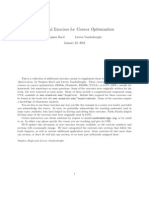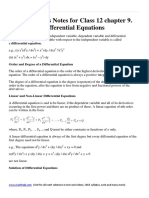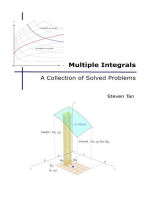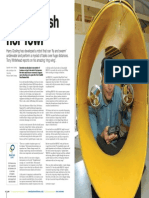Business23 Leibniz Notation of The Derivative
Business23 Leibniz Notation of The Derivative
Uploaded by
marchelo_cheloCopyright:
Available Formats
Business23 Leibniz Notation of The Derivative
Business23 Leibniz Notation of The Derivative
Uploaded by
marchelo_cheloOriginal Description:
Original Title
Copyright
Available Formats
Share this document
Did you find this document useful?
Is this content inappropriate?
Copyright:
Available Formats
Business23 Leibniz Notation of The Derivative
Business23 Leibniz Notation of The Derivative
Uploaded by
marchelo_cheloCopyright:
Available Formats
Arkansas Tech University
MATH 2243: Business Calculus
Dr. Marcel B. Finan
13 Leibniz Notation for The Derivative
When dealing with mathematical models that involve derivatives it is conve-
nient to denote the prime notation of the derivative of a function y = f(x)
by
dy
dx
. That is,
dy
dx
= f
(x)
This notation is called Leibniz notation (due to W.G. Leibniz). For exam-
ple, we can write
dy
dx
= 2x for y
= 2x.
When using Leibniz notation to denote the value of the derivative at a point
a we will write
dy
dx
x=a
Thus, to evaluate
dy
dx
= 2x at x = 2 we would write
dy
dx
x=2
= 2x|
x=2
= 2(2) = 4.
Remark 13.1
Even though
dy
dx
appears as a fraction but it is not. It is just an alterna-
tive notation for the derivative. A concept called dierential will provide
meaning to symbols like dy and dx.
One of the advantages of Leibniz notation is the recognition of the units
of the derivative. For example, if the position function s(t) is expressed in
meters and the time t in seconds then the units of the velocity function
ds
dt
are meters/sec.
In general, the units of the derivative are the units of the dependent variable
divided by the units of the independent variable.
Example 13.1
The cost, C ( in dollars) to produce x gallons of ice cream can be expressed
as C = f(x). What are the units of measurements and the meaning of the
statement
dC
dx
x=200
= 1.4?
1
Solution.
dC
dx
is measured in dollars per gallon. The notation
dC
dx
x=200
= 1.4
means that if 200 gallons of ice cream have already been produced then the
cost of producing the next gallon will be roughly 1.4 dollars.
Example 13.2
The derivative of the velocity function v is called acceleration and is denoted
by a. Suppose that v is measured in meters/seconds, what are the units of
a?
Solution.
The units of a are meters/seconds/seconds = meters/seconds
2
.
Local Linear Approximation
Finally, one can use the derivative at a point to approximate values of the
function at nearby points. For example, if we know the values of f(a) and
f
(a) then for a nearby point b the value of f(b) is found by the formula
f(b) f
(a)(b a) + f(a).
Example 13.3
Climbing health care costs have been a source of concern for some time. Use
the data in the table below to estimate the average per capita expenditure
in 1991 and 2010 assuming that the costs climb at the same rate since 1990.
Year 1970 1975 1980 1985 1990
Per capita expenditure ($) 349 591 1055 1596 2714
Solution.
Between 1985 and 1990 the rate of increase in the costs is
27141596
5
= $223.60
per year. Since we are assuming that the costs continue to increase at the
same rate. we can write
C(1991) C(1990) + C
(1990)(1991 1990) = 2714 + 223.60 = $2937.60
and
C(2010) = 2714 + 223.60(10) = $7, 186.
2
You might also like
- HubSpot CaseDocument6 pagesHubSpot CaseDipanshu Singh100% (1)
- Chapter 2 Recognizing Opportunities and Generating IdeasDocument28 pagesChapter 2 Recognizing Opportunities and Generating IdeasKishoNo ratings yet
- Social Learning Theory BANDURADocument2 pagesSocial Learning Theory BANDURAkejuterbang100% (1)
- ISO 127025 Quality Manual SampleDocument6 pagesISO 127025 Quality Manual SampleTamer Farouk Khalifa100% (1)
- Cal24 Leibniz Notation For The DerivativeDocument2 pagesCal24 Leibniz Notation For The Derivativemarchelo_cheloNo ratings yet
- CS132Module3 Calculus EssentialNotes by DMiguelDocument3 pagesCS132Module3 Calculus EssentialNotes by DMiguelDhuanne EstradaNo ratings yet
- Differential Equations and Slope Fields IntroDocument5 pagesDifferential Equations and Slope Fields IntrobadfpsNo ratings yet
- Chapter-2-REPRESENTATION OF CONTROL COMPONENTSDocument38 pagesChapter-2-REPRESENTATION OF CONTROL COMPONENTSMuhammad FadilNo ratings yet
- The Integration Process: D FX FX DX D DXDocument2 pagesThe Integration Process: D FX FX DX D DXMelvin EsguerraNo ratings yet
- Diff ErrorDocument4 pagesDiff ErrorSai Swetha KVNo ratings yet
- Chapter 4 - Applications of DerivativesDocument132 pagesChapter 4 - Applications of DerivativesPhúc HồngNo ratings yet
- First Year Calculus: WwlchenDocument10 pagesFirst Year Calculus: WwlchenPrince Emmanuel ChukwuemekaNo ratings yet
- Elementary Differential Equations: Notice: This Material Must Not Be Used As A Substitute For Attending The LecturesDocument34 pagesElementary Differential Equations: Notice: This Material Must Not Be Used As A Substitute For Attending The LecturesDelvina HartrianaNo ratings yet
- L24 PipesPart3 CalculatorsDocument18 pagesL24 PipesPart3 CalculatorsBinyam KebedeNo ratings yet
- Algebra Geometry Statistics AllDocument26 pagesAlgebra Geometry Statistics AllDwin donever PacuriNo ratings yet
- Differentials and Error PDFDocument4 pagesDifferentials and Error PDFLuis Ignacio Lomeli GalazNo ratings yet
- BV Cvxbook Extra ExercisesDocument156 pagesBV Cvxbook Extra ExercisesAnonymous WkbmWCa8MNo ratings yet
- Additional Exercises For Convex Optimization: Stephen Boyd Lieven Vandenberghe March 30, 2012Document143 pagesAdditional Exercises For Convex Optimization: Stephen Boyd Lieven Vandenberghe March 30, 2012api-127299018No ratings yet
- BV Cvxbook Extra ExercisesDocument139 pagesBV Cvxbook Extra ExercisesAkhil AmritaNo ratings yet
- Aditional Exercises Boyd PDFDocument164 pagesAditional Exercises Boyd PDFlandinluklaNo ratings yet
- Appendix A 2Document6 pagesAppendix A 2ErRajivAmieNo ratings yet
- Chapter 3 - DerivativesDocument46 pagesChapter 3 - DerivativesDương DũngNo ratings yet
- BITSAT 2023 Paper Memory BasedDocument19 pagesBITSAT 2023 Paper Memory Basedkrishbhatia1503No ratings yet
- Solving 01Document12 pagesSolving 01bongoneshian2No ratings yet
- The Fundamental Theorem of CalculusDocument5 pagesThe Fundamental Theorem of CalculusDaiszyBarakaNo ratings yet
- Learning Outcome 4 - Ac 2 (Analytical Methods)Document4 pagesLearning Outcome 4 - Ac 2 (Analytical Methods)Chan Siew ChongNo ratings yet
- Fas F (N) F (D) .: Pete L. ClarkDocument6 pagesFas F (N) F (D) .: Pete L. Clarksticker592No ratings yet
- Week 017 Calculus I - Definition of The Definite IntegralDocument7 pagesWeek 017 Calculus I - Definition of The Definite Integralvit.chinnajiginisaNo ratings yet
- MATH21Document11 pagesMATH21NilushaNo ratings yet
- Pchem11e Toolkit 04Document1 pagePchem11e Toolkit 04Lê Anh MịnhNo ratings yet
- Calculus Practice Test: Directions: Solve The Following Problems. Show All Your WorkDocument5 pagesCalculus Practice Test: Directions: Solve The Following Problems. Show All Your WorkteachopensourceNo ratings yet
- Lesson 1-2 PDFDocument25 pagesLesson 1-2 PDFRex FajardoNo ratings yet
- The Definite Integral SummationDocument7 pagesThe Definite Integral Summationmandy lagguiNo ratings yet
- Integral CalculusDocument25 pagesIntegral CalculusLiregine CaymeNo ratings yet
- Maths IntgrationDocument153 pagesMaths IntgrationLI DiaNo ratings yet
- Calc 3 Lecture Notes Section 12.4 1 of 7Document7 pagesCalc 3 Lecture Notes Section 12.4 1 of 7Nicholas MutuaNo ratings yet
- Integral Vector Calculus: Learning OutcomesDocument33 pagesIntegral Vector Calculus: Learning Outcomesmahyar777100% (1)
- Mathematics Notes and Formula For Class 12 Chapter 9. Differential Equations - 2Document7 pagesMathematics Notes and Formula For Class 12 Chapter 9. Differential Equations - 2Anonymous GGtvR65MRNo ratings yet
- Chapter 11 - Section B - Non-Numerical Solutions: T T T P P PDocument8 pagesChapter 11 - Section B - Non-Numerical Solutions: T T T P P PRinny Kynar PratiwiNo ratings yet
- Putting Differentials Back Into CalculusDocument14 pagesPutting Differentials Back Into Calculus8310032914No ratings yet
- Homothetic FunctionsDocument2 pagesHomothetic FunctionsAli LatifNo ratings yet
- 2014 Lecture 006Document32 pages2014 Lecture 006eouahiauNo ratings yet
- Chapter 1 - The IntegralDocument12 pagesChapter 1 - The IntegralKevin XavierNo ratings yet
- MATH 115: Lecture IV NotesDocument5 pagesMATH 115: Lecture IV NotesDylan C. BeckNo ratings yet
- Part 2Document6 pagesPart 2achampetNo ratings yet
- Engineering Mathematics 4Document41 pagesEngineering Mathematics 4Ali SNo ratings yet
- Chain RuleDocument8 pagesChain RuletxungoNo ratings yet
- Calculus BC For DummiesDocument12 pagesCalculus BC For DummiesJoon KoNo ratings yet
- Techniques of Integration: 6.1 Differential NotationDocument25 pagesTechniques of Integration: 6.1 Differential NotationCHERUYIOT IANNo ratings yet
- Calc 111 Module 7 WK 13 14Document9 pagesCalc 111 Module 7 WK 13 14colby kodyNo ratings yet
- RL11 2022Document8 pagesRL11 2022Thando LundweNo ratings yet
- Partial Derivative CalculatorDocument4 pagesPartial Derivative Calculatorapi-140032165No ratings yet
- Defslt Lec # 03 13-01-21Document7 pagesDefslt Lec # 03 13-01-21AkashNo ratings yet
- Lesson 2 Definite IntegralsDocument6 pagesLesson 2 Definite IntegralsKarl Patrick SiegaNo ratings yet
- Math For Machine Learning: 1.1 Differential CalculusDocument21 pagesMath For Machine Learning: 1.1 Differential CalculusjoekowalskyNo ratings yet
- Digital Watermarking of Images in The Fractional Fourier DomainDocument14 pagesDigital Watermarking of Images in The Fractional Fourier DomainNavdeep GoelNo ratings yet
- How To Solve A Differential EquationDocument8 pagesHow To Solve A Differential Equationmenonharsh100% (4)
- Algebraic Curves, Projective Mappings and B Ezout's Theorem: 2 NotationDocument10 pagesAlgebraic Curves, Projective Mappings and B Ezout's Theorem: 2 NotationSon HoangNo ratings yet
- Project Deliverable 1Document4 pagesProject Deliverable 1Vishalkumar BhattNo ratings yet
- Lithium Batteries Science and TechnologyDocument766 pagesLithium Batteries Science and Technologymarchelo_cheloNo ratings yet
- Outline: Chris Karlof, Naveen Sastry, and David WagnerDocument22 pagesOutline: Chris Karlof, Naveen Sastry, and David Wagnermarchelo_cheloNo ratings yet
- Sistemas de Sensores en Red Lectura27Document4 pagesSistemas de Sensores en Red Lectura27marchelo_cheloNo ratings yet
- A Study of Electro Materials For Lithium-Ion BatteriesDocument204 pagesA Study of Electro Materials For Lithium-Ion Batteriesmarchelo_cheloNo ratings yet
- Sistemas de Sensores en Red Lectura26-ADocument19 pagesSistemas de Sensores en Red Lectura26-Amarchelo_cheloNo ratings yet
- Sistemas de Sensores en Red Lectura27Document4 pagesSistemas de Sensores en Red Lectura27marchelo_cheloNo ratings yet
- Sistemas de Sensores en Red Lectura21Document2 pagesSistemas de Sensores en Red Lectura21marchelo_cheloNo ratings yet
- Sistemas de Sensores en Red Lecture19Document7 pagesSistemas de Sensores en Red Lecture19marchelo_cheloNo ratings yet
- Sistemas de Sensores en Red Lectura26Document1 pageSistemas de Sensores en Red Lectura26marchelo_cheloNo ratings yet
- The Secure Aggregation Problem Algorithm Description Algorithm AnalysisDocument30 pagesThe Secure Aggregation Problem Algorithm Description Algorithm Analysismarchelo_cheloNo ratings yet
- Sistemas de Sensores en Red Lectura24Document20 pagesSistemas de Sensores en Red Lectura24marchelo_cheloNo ratings yet
- Sistemas de Sensores en Red Lectura9-CDocument26 pagesSistemas de Sensores en Red Lectura9-Cmarchelo_cheloNo ratings yet
- Sistemas de Sensores en Red Lectura17Document5 pagesSistemas de Sensores en Red Lectura17marchelo_cheloNo ratings yet
- Sistemas de Sensores en Red Lectura17Document5 pagesSistemas de Sensores en Red Lectura17marchelo_cheloNo ratings yet
- Sistemas de Sensores en Red Lecture10Document17 pagesSistemas de Sensores en Red Lecture10marchelo_cheloNo ratings yet
- Sistemas de Sensores en Red Lectura9-ADocument12 pagesSistemas de Sensores en Red Lectura9-Amarchelo_cheloNo ratings yet
- 2023 NIHR ACF Guidance For Recruitment and Appointment (Medical) v1.0Document34 pages2023 NIHR ACF Guidance For Recruitment and Appointment (Medical) v1.0Oscar Zhen Yu WongNo ratings yet
- Implementing ICT in ClassroomDocument28 pagesImplementing ICT in ClassroomSuhamira NordinNo ratings yet
- EMAN11Document3 pagesEMAN11Borje DelonNo ratings yet
- J.L. Schafer - Analysis of Incomplete Multivariate Data-Chapman and Hall - CRC (1997)Document514 pagesJ.L. Schafer - Analysis of Incomplete Multivariate Data-Chapman and Hall - CRC (1997)torrellchenNo ratings yet
- CSC4316 9Document40 pagesCSC4316 9Jamil SalisNo ratings yet
- The Identification and Prevention of Cybercrime in The Healthcare IndustryDocument10 pagesThe Identification and Prevention of Cybercrime in The Healthcare IndustryImran AlamNo ratings yet
- Thesis Statement On Pro Animal TestingDocument7 pagesThesis Statement On Pro Animal Testingdianaolivanewyork100% (2)
- Work Samples and Simulations: Machine LearningDocument80 pagesWork Samples and Simulations: Machine Learningahmad shomaliNo ratings yet
- c706 PDFDocument5 pagesc706 PDFstarkNo ratings yet
- CH 07 CLTDocument14 pagesCH 07 CLTJezzel AnnaNo ratings yet
- The Challenges of Nigerian Agricultural Firms in Implementing The Marketing ConceptDocument10 pagesThe Challenges of Nigerian Agricultural Firms in Implementing The Marketing Conceptrohan singhNo ratings yet
- Exploring The Business Case For E-ProcurementDocument29 pagesExploring The Business Case For E-ProcurementNaufal S AmaanullahNo ratings yet
- Effective Business Communications Final BUSN20017Document13 pagesEffective Business Communications Final BUSN20017anup shresthaNo ratings yet
- Management AccountingDocument19 pagesManagement AccountingJean Fajardo BadilloNo ratings yet
- Thesis/Dissertation Adviser'S Review Guide For Qualitative ResearchDocument7 pagesThesis/Dissertation Adviser'S Review Guide For Qualitative ResearchZymarl Abigail FernandezNo ratings yet
- Gender and PlaceDocument6 pagesGender and PlaceVictorNo ratings yet
- A Case Study of A Scrum Project (PDFDrive)Document37 pagesA Case Study of A Scrum Project (PDFDrive)Upendra SharmaNo ratings yet
- الخصائص اللميز لمنظات الاداء العاليDocument255 pagesالخصائص اللميز لمنظات الاداء العاليqoseNo ratings yet
- Mathematical Foundations of Computer ScienceDocument24 pagesMathematical Foundations of Computer Sciencemurugesh72No ratings yet
- Lactating HerbsDocument33 pagesLactating HerbsShen RondinaNo ratings yet
- POM Model Question PDFDocument2 pagesPOM Model Question PDFKani MozhiNo ratings yet
- Neither Fish Nor Fowl, Profile On GO ScienceDocument2 pagesNeither Fish Nor Fowl, Profile On GO ScienceASeaSlugNo ratings yet
- Professional Growth Essentially RefersDocument4 pagesProfessional Growth Essentially RefersMylene N. MacedaNo ratings yet
- Chapter 3 - 01 15Document14 pagesChapter 3 - 01 15MariaNo ratings yet
- Lo NotesDocument19 pagesLo NotesHlayiseko RikhotsoNo ratings yet
- Projects and Business ValueDocument35 pagesProjects and Business ValueYao SelomNo ratings yet









































































































